 |
 |







|
 |
 |
 |
 |
 |
 |
 moving minnesota through employee communication moving minnesota through employee communication |
 |
 |
 May
16, 2001 May
16, 2001 |
No. 14 |
 |
|
|
 |
 |
 |
Commission recommends funding overhaul for large transportation projects
|
 |
 |
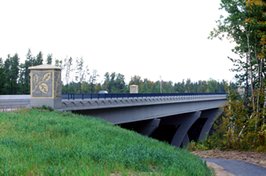 |
Hwy 371 from Little Falls to Brainerd is a heavily
traveled recreational corridor with regional impact. With a reconstruction
cost of $106 million, this major project far exceeds 25 percent of District
3’s budget. The cost includes right-of-way purchase, upgrade to four lanes,
a new rest area and an interchange. Photo by David Larson
|
The 2001 legislative session hasn’t ended yet, but already the engine has started
running on one aggressive transportation proposal headed for the 2002 session.
On May 8, the state’s Major Transportation
Projects Commission announced that it would introduce next session a proposal
creating a separate fund for large transportation projects. The commission, created by the 2000 Legislature,
said that this fund would cover 60 major transportation projects, each of which
exceeds 25 percent of a district’s budget. (That comes to about $8 million in
northern Minnesota and more than $60 million in the Twin Cities area.)
“The proposal we are developing
would signal a funding increase, then identify and then track projects in a
separate major projects fund,” said David Jennings, the commission’s chair.
“The fund would be for projects of regional significance, projects that should
not be confined by their physical location. Major transportation projects have
regional and statewide significance that exceed the jurisdictions of those most
closely involved.”
Commissioner Elwyn Tinklenberg noted: “We’re
willing to consider any proposal that would provide direly needed new funding
for transportation, especially for huge projects with regional significance.”
The commission cited the following projects as examples:
§
Hwy 14 from Hwy 60 to Waseca (cost: $90 million); and
§
Hwy 212 through the southwestern Minneapolis suburbs (cost: $205
million).
Earlier this year the commission advised Gov. Ventura and legislators to add
at least $500 million annually to the state transportation budget above currently
anticipated resources, and to consider raising and indexing the current gasoline
tax.
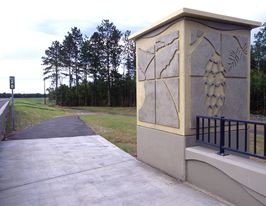 |
|
The seven-mile Hwy 371 project that skirts the western edge of Brainerd
earned several awards, including recognition for construction excellence,
rideability, project complexity, aesthetics, respect for the environment
and work zone safety. Photo by David Larson
|
“Rather than simply rearrange the deck chairs on the Titanic,” Jennings said,
“we suggest an aggressive plan to seek out a real solution to funding and delivering
large transportation projects. Because there are no additional funds, we are
forced to resort to incremental approaches to building major projects—building
them in several small stages over a disruptive period of many years.”
According to Jennings, current methods of distributing already-identified funds
may provide geographic equity and local input, but total funding in any given
district isn’t adequate to do more than meet routine road maintenance demands.
“Local input is valued and important, but these projects are critical to the
economic well being of our entire state,” said Jennings. “So, in addition to
funding and management oversight, our recommendations will include revisions
to municipal consent and right-of-way acquisition laws, as well as the current
environmental compliance and contracting processes.
Commission members include a representative of the Governor’s Office, four
citizens appointed by the governor, seven state senators and seven state representatives.
|
back

|
 |
Conference committee to address transportation
funding today
|
 |
 |
With less than a week to go in the legislative
session, the fate of transportation funding for the next biennium is now in
the hands of the Omnibus Transportation and Public Safety Conference Committee.
The committee was scheduled to begin meeting today.
“We are getting down to the wire,” said Betsy Parker,
associate director, Government Relations. Parker and other Mn/DOT staff have
been on stand-by for days waiting for the conference committee to take up the
omnibus transportation funding bill that regulates not only transportation,
but also criminal justice and public safety prevention programs. Besides funding,
the bill contains several policy issues that also need to be addressed.
Parker attributes the delay in part to the fact
that as of Tuesday night, House and Senate leadership had not yet established
funding limits for the conference committees.
The legislative session must end by midnight, May
21. Before that time, the conference committee must iron out differences in
their bills and send the compromise to the floor of both houses to be voted
on. No amendments can be made to the bill on the floor. If one house votes the
bill down, it goes back to the conference committee and the process begins again.
Gov. Ventura has indicated that he will not call a special session to finish
up legislative business if all is not complete by the May 21 deadline.
The bills the House and Senate have passed both
would appropriate about $3.2 billion for transportation over the next biennium,
Parker said. The difference is in how they want that money spent.
Additionally, both the House and the Senate are
proposing constitutional amendments to dedicate motor vehicle sales tax revenue,
which would be presented to voters in November 2002. The House bill would dedicate
60 percent of the MVST revenue for transportation—32 percent to offset reductions
in license tab fees and the rest for roads and bridges (approximately $165 million
per year of new funding). The Senate’s proposal, on the other hand, would use
50 percent of the MVST funds for transportation—32 percent to offset license
tab fee reductions and the rest for a transit assistance fund.
Conference committee members are senators Dean
Johnson, Randy Kelly, Mark Ourada, Jane Ranum and Roy Terwilliger; and representatives
Mary Liz Holberg, Mary Murphy, Carol Molnau, Rich Stanek and Tom Workman.
For more information about legislative issues affecting
Mn/DOT, contact Joe Hudak at 651/297-5149, click on Mn/DOT’s weekly legislative summary
or check out its Government Relations
Web site. See also the Minnesota Legislature
Web page.
|
back

|
 |
May 17 is B-BOP day
|
 |
 |
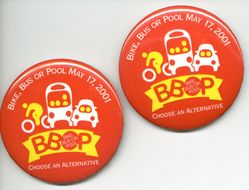 |
Celebration of the 10th annual B-BOP Day begins early
on May 17.
|
Cheers and “Huzzahs!” will be in order tomorrow morning as B-BOP (Bike, Bus
or Pool) Day participants arrive at work (between 8:00 a.m. and 8:30 a.m.) via
alternative transportation. Organized B-BOP events will take place in downtown
Minneapolis, Rochester, St. Cloud and the State Capitol Complex in St. Paul.
B-BOP Day’s purpose includes focusing attention on using bus transit, carpools,
vanpools, walking, biking and telecommuting to alleviate congestion and reduce
demand on the state’s transportation system.
Even if you do not plan to B-BOP, attend the events anyway to learn more about
transportation options. For more information, visit the B-BOP Day Web site, or call Jarvis
Keys, Transit, 651/297-3702.
|
back

|
 |
Inspections precede reopening of flooded bridges
|
 |
 |
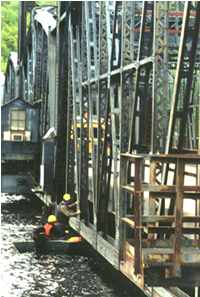 |
|
Metro bridge inspectors check out the Stillwater Bridge
prior to the bridge's reopening on May 11. Photo by Kent Barnard
|
An informal survey of the districts by the Office
of Bridges and Structures determined that approximately 25 bridges were closed
during the flooding this spring, according to Paul Rowekamp, North Region bridge
engineer.
Although the effects of flooding varied around
the state, every district and Metro Division had at least one structure closed
because of high water levels. Some of the bridges were closed less than 24 hours,
while others—particularly in west central and southern Minnesota—were closed
for several weeks.
Now that the floodwaters are receding, Mn/DOT’s bridge inspectors are carefully
examining any bridges affected by high water. While flooding may not have actually
covered a structure, district crews were forced to close bridges in many locations
because of water across the approach roadways.
Bridge inspections focus on the two main sections of a bridge: the substructure
and the superstructure. The substructure, or foundation, of the bridge consists
of the footings, abutments and piers. Superstructure elements include the girders,
deck and overhead trusses that normally rest above the water on the foundation.
Substructure inspection is necessary to determine if there has been any scour
(erosion) around the abutments or pier footings of the bridge. Inspection crews
use sonar, probes or sounding weights to measure the bottom of the riverbed
to determine if the fill material has washed away.
If no scour is discovered, the substructure is in no danger, according to Dan
Dorgan, state bridge engineer. Even if inspectors find scour, bridges are designed
to withstand some erosion around foundations. When repair is necessary, maintenance
crews may use large rocks to fill around and protect the pier footings.
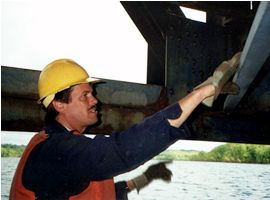 |
|
Curt Fuhrman, Metro bridge inspector, checks under
the Stillwater Bridge. Photo by Kent Barnard
|
A visual inspection is conducted to determine if there is any damage to the
superstructure of the bridge, which can be susceptible to water pressure moving
it from the foundation. During flooding, portable concrete median barriers are
sometimes placed on the bridge deck to weight it down to prevent movement of
the bridge from its foundation. By sighting along the bridge railing or girders,
workers can readily determine if the bridge has moved and is out of alignment
on its supports.
Debris such as logs or ice is also removed from the bridge once workers can
safely reach the structure from the water surface. A thorough visual inspection
of the underside of the bridge also is made at this time for damage.
Finally, the approach roadways leading to the structure are examined for any
evidence of movement, settling or other damage that can cause misalignment of
the road and bridge.
Following a successful inspection, the bridge is reopened to traffic and is
re-inspected as scheduled by Mn/DOT. Depending on their age and condition,
the state’s 4,600 bridges are inspected every one to two years.
For more information, contact Dan Dorgan, 651/747-2101.
By Kent Barnard
|
back

|
 |
Bahler named TOCC program manager
|
 |
 |
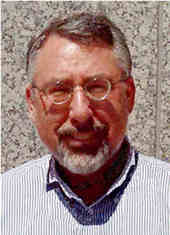 |
|
Steve Bahler is the new TOCC program manager.
Photo by Kent Barnard
|
Steve Bahler has been appointed Program Manager for the Transportation Operations
and Communications Center program, announced Jim Swanson, assistant commissioner,
Program Delivery Group. He replaces Dick Maddern, who accepted a position as
Safety Officer in Virginia.
Swanson said Bahler’s appointment coincides with an organizational change shifting
overall responsibility for statewide TOCC deployment from the Program Support
Group to the Program Delivery Group.
Bahler started with Mn/DOT in May 1997, working in the Office of Advanced Transportation
Systems as deputy and assistant director, and as the intelligent transportation
systems program manager.
Prior to Mn/DOT, Bahler worked for the Federal
Highway Administration in Baltimore, Washington D.C., San Francisco and St.
Paul. His last assignment with FHWA included working with Mn/DOT's Guidestar
ITS program.
Bahler has a bachelor’s degree in civil engineering.
His new office is in the Central Office, Room G-32; his phone number is 651/296-0152.
|
back

|
 |
Reminder: online clippings put news at your fingertips
|
 |
 |
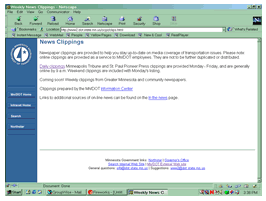 |
Daily news clippings
from the StarTribune and the Pioneer Press are now available online.
|
What do the Stillwater Bridge re-opening, a capitol briefing, and the light
rail–Xcel case have in common? They were all subjects of stories in the Star
Tribune or Pioneer Press this week.
Thanks to the Information Center staff, Mn/DOT employees no longer have to
try to beat their co-workers to the newspaper to make sure they stay up-to-date
on transportation issues. Daily clippings from both newspapers are at your fingertips
on Mn/DOT’s intranet.
The online clippings are provided as a service to Mn/DOT employees. They may
not be further copied or distributed, notes Cathy Sullivan, Information Center
manager.
Check out the clippings at http://www2/ocpr/clips.html.
By Kay Korsgaard
|
back

|
 |
Question of the Week
|
 |
 |
This week’s question is for our readers: “Have we really answered all of your
questions? How about questions from friends, family, neighbors, or strangers?”
We have a hard time believing that this could be true, even though our mailbox
is running low. Consider this:
§
The Legislative session is winding down (it ends May 21)
§
Road construction season has begun in earnest around the state,
with more than 250 projects in the works
§
Maintenance workers around the state are testing innovative new
equipment, methods, procedures and schedules
§
Planning and design sections have several thousand projects in
development stages
§
We have many high-profile projects drawing national (and even
international) attention, such as Mn/ROAD, non-salt de-icing materials, light
rail transit, commuter rail, ramp meter testing, intelligent transportation
system traveler information initiatives, and environmental preservation projects
§
Mn/DOT units win professional and trade awards of excellence year
after year, often for innovations and significant improvements on previous methods
§
Market Research has gathered data on public perceptions, wants
and needs, which can help us plan our work—or anticipate questions from strangers
§
Mn/DOT gets daily local media coverage from radio and web news
outlets, along with considerable (often weekly) attention from area newspapers,
news magazines and television newscasts
That’s a LOT of information to track…and sooner or later, we all run into someone
who expects us to know the answer to a specific question.
We’re here to help you with that situation. Let us know what you need to know
to answer your neighbors’ questions—or to satisfy your own curiosity. We’ll
talk to the right information sources and get back to you with something you
can use.
So, what do you want to know first?
|
back

|

|
|
 |
|
|


